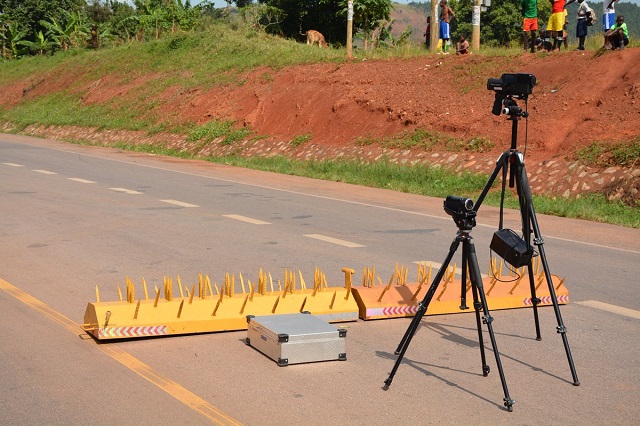
Nampijja says despite the poor visibility in foggy conditions, motorists hardly seem to pay attention and continue speeding. She says the carnage on the highway is from a combination of careless driving, speeding, and motorists who ignore road signs and markings.
“They will overtake at sections where they are not supposed to do so and where a section has been marked out for 50km/hr, some motorists will not pay attention and will do 120km/hr,” she says.
It is not long before I encounter exactly what Nampijja was possibly talking about.
We are driving down a swampy valley at a place called Nabusanke, and the driver of our 35-seater mini-bus is speeding gaily. Soon he decides to overtake a 10-wheeler long truck laden with red tiles which in turn is overtaking a trailer. Soon the three vehicles are hurtling shoulder-to shoulder downhill in a horizontal show of might and speed that cuts off the road to any oncoming traffic. We are lucky there is none and our youthful driver soon pulls in front and swings back into his lane. With the race won, he appears to reward himself by changing the music playing on his CD— from Paul Kafeero’s melancholic ballad to a dancehall zouk beat by Oliver Ngoma.
Later, when I recount the incident to Mukasa, he says that was suicidal. He says Masaka highway has several winding corners, and some corners are in valleys.
“Under the Highway Code, you cannot overtake in a valley because you may not see properly 100 metres ahead,” he says.
I recall years back when the Masaka highway was really narrow. It would have been impossible for our driver to do what he had recklessly done. Back then, the road was also pothole- riven and the gulleys deterred speeding. Today all is changed. The road is as smooth as a baby’s tongue and vehicles seem to be just sliding along. No wonder many drivers complain that “it is too slippery”.
One of them is John Nduggwa; a taxi driver who has plied the Kampala-Masaka highway for the last 13 years. Although he is no engineer, he says the type of asphalt used is the wrong type.
“It is too smooth for vehicles, especially when it rains,” he says.
MP Kivumbi agrees. For him, the fact that the sections where accidents frequently occur are being redone means “there were issues with the way this road was rehabilitated”.
But the engineers at UNRA, who oversaw the works, disagree.
“After the road was handed over, tests were done on materials used by auditors and they found that it met the requirements,” says Isaac Wani, the director network planning and engineering at UNRA.
“Until motorists get to behave and learn the Highway Code, we will continue having these nasty accidents,” says Mukasa.
Still, he says, UNRA is in the process of testing the skid resistance of some sections along the road where complaints have persistently been raised.
“Visually, the road looks fine, but the slippery nature of specific sections of the road will be tested,” he says.
Wani also refutes claims that the road is narrow by international standards. He says even before the rehabilitation, the road was wide enough at 7.5metres. He says it was expanded to 11 metres to cater for climbing lanes in some sections.
Climbing lanes, which are at the extreme left of the road in certain sections, were introduced after the highway’s rehabilitation, for instance, to create a middle lane for fast moving vehicles. Motorists coming from the opposite direction to the climbing lane must not use that lane because they do not have that right.
But often times, that is never the case as vehicles accelerating downhill at faster speeds than those climbing use the middle lane in error. Possibly they see no problem overtaking in valleys and sense no danger.
But, if everything looks fine, why has a problem which government intended to solve by rehabilitating the road only got worse?
Wani blames an increase in traffic. He says Masaka highway was designed to handle traffic of low density but a lot has changed over the last one decade.
“What has happened is that Uganda’s economy has grown and the vehicles have exceeded what was originally planned not only for Masaka road but also on all the other highways,” he says, “The design speeds that were earlier on provided on all Uganda’s highways have been overtaken because of capacity.
“We can talk about other issues but the fact is we cannot afford to overtake anymore even in zones that have been marked for overtaking.”
Wani says UNRA has already done a study and found that all roads within a radius of 60km from Kampala should be dual-carriage ways considering the volume of traffic the roads carry every day.
The roads agency is also soon embarking on a 12-month study that hopes to come up with a master plan for expressways that connects Uganda’s major towns and neighbouring countries.
Meanwhile, police say, they have observed that ignorance of road signs, marks, and signals is one of the reasons why traffic accidents are rampant on Masaka road.
“Until motorists get to behave and learn the Highway Code, we will continue having these nasty accidents,” says Mukasa.
He says education, information, and sensitization of motorists, which until recently were neglected needs to be scaled up for road users along this highway.
On July 27 Police randomly engaged motorists on basic road traffic signs and markings along the highway and intends to carry out this exercise every Tuesday. Hopefully, these interventions will reduce on the massacre on Masaka road.
****
editor@independent.co.ug
 The Independent Uganda: You get the Truth we Pay the Price
The Independent Uganda: You get the Truth we Pay the Price


